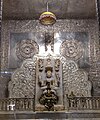Padmavati (Jainism)
| Padmavati | |
|---|---|
 Padmavati, 10th century, Metropolitan Museum of Art | |
| Personal information | |
| Spouse | Dharanendra |
| Part of a series on |
| Jainism |
|---|
 |
Padmāvatī is the protective goddess or śāsana devī (शासनदेवी) of Pārśvanātha, the twenty-third Jain tīrthāṅkara, complimenting Parshwa yaksha, the shasan deva.[1] She is a yakshi (attendant goddess) of Parshwanatha.[2]
Jain Biography[edit]
There is another pair of souls of a nāga and nāginī who were saved by Parshwanath while being burnt alive in a log of wood by the tapas kamath, and who were subsequently reborn as Indra (Dharanendra in particular) and Padmavati (different from sashan devi) after their death.[3] According to the Jain tradition, Padmavati and her husband Dharanendra protected Lord Parshvanatha when he was harassed by Meghmali.[4][5] After Padmavati rescued Parshvanatha grew subsequently powerful in to yakshi, a powerful tantric deity and surpassed other snake goddess Vairotya.[6]
Legacy[edit]
Worship[edit]

Goddess Padmavati along with Ambika, Chakreshvari are held as esteemed deities and worshipped in Jains along with tirthankaras.[7][8] Ambika and Padmavati are associated with tantric rituals. Both Padmavati and Dharanendra are revered exclusively as powerful intercessor deities.[1] These tantric rites involves yantra-vidhi, pitha-sthapana and mantra-puja.[9][6] Friday of every week is particularly popular day to worship the Goddess.[10]
In literature[edit]
- Bhairava-Padmavati-Kalpa written by Mallisena in 12th century is tantric text to worship Padmavati. The text discusses rites connected with Padmavati, namely, stambha, vasya, akarsana, nimitta-jnana, garuda tantra etc.[11]
- Adbhuta-Padmavati-Kalpa is Shvetambar text composed by Shri Chandra Suri, 12th century.[11]
- Padmavati-astaka composed by Shvetambar scholar Parshvadeva gani is commentary of various tantric rites.[11]
- Padmavati-catusadika composed by Jinaprabha suri.[11]
- Padmavati-Pujanama, Padmavati-strota, Padmavati-sahasra-nama-strota, Rakta-Padmavati-Kalpa are tantric text dedicated to Padmavati.[11]
Iconography[edit]
A snake's hood covers her head, and she sits on a lotus flower. Often a small image of the Lord Parshvanatha is placed in her crown. She may be depicted as four-armed, carrying noose and rosary (japa mala), elephant goad, lotus and a fruit.[4] Yaksha-Yakshi pair sculptures of Padmavati Ambika and Dharanendra are one of the most favoured along with Gomukha-Chakreshwari and Sarvahanabhuti-Ambika.[12]
'Mandala of Padmavati', bronze, Walters Art Museum, 11th century
Goddess Padmavati at Hanumantal Bada Jain Mandir, Jabalpur
Sculpture of Goddess Padmavati in Akkana Basadi, 12th century
Goddess Padmavati at Walkeshwar Jain Temple
Padmavati at Shri Mahavirji
Main temples[edit]
- Padmakshi Gutta
- Padmavati temple, Humcha, 7th century temple
See also[edit]
References[edit]
Citation[edit]
- ↑ 1.0 1.1 Cort 2010, p. 186.
- ↑ Cort 1987, pp. 235–255.
- ↑ Babb 1996, p. 33.
- ↑ 4.0 4.1 Jain & Fischer 1978, p. 21.
- ↑ Sūri, Raval & Shah 1987, p. 267.
- ↑ 6.0 6.1 Shah 1987, p. 221.
- ↑ Krishna 2014, p. 68.
- ↑ Chawdhri 1992, p. 128.
- ↑ Tiwari 1989, p. 29.
- ↑ Dundas 2002, pp. 213-214.
- ↑ 11.0 11.1 11.2 11.3 11.4 Shah 1987, p. 277.
- ↑ Tiwari 1989, p. 13.
Source[edit]
- Dundas, Paul (2002) [1992], The Jains (Second ed.), London and New York: Routledge, ISBN 978-0-415-26605-5
- Shah, Umakant P. (1987), Jaina Iconography, Abhinav Publications, ISBN 978-81-7017-208-6
- Jain, Jyotindra; Fischer, Eberhard (1978), Jaina Iconography, Leiden: BRILL, ISBN 978-90-04-05259-8
- Cort, John (2010). Framing the Jina: Narratives of Icons and Idols in Jain History. Oxford University Press. ISBN 9780199739578.
- Babb, Lawrence A. (1996). Absent Lord: Ascetics and Kings in a Jain Ritual Culture. Berkeley, Calif.: University of California Press. ISBN 9780520203242. Retrieved 22 September 2017.
- Tiwari, Dr. Maruti Nandan Prasad (1989). Ambika in Jaina Art and Literature. Bharatiya Jnanpith.
- Krishna, Nanditha (2014). Sacred Plants of India. Penguin UK. ISBN 9789351186915.
- Chawdhri, L. R. (1992). Secrets of Yantra, Mantra and Tantra. Sterling Publishers Pvt. Ltd. ISBN 9781845570224.
- Sūri, Padmasundara; Raval, D. P; Shah, Nagin J (1987). Padmasundarasūriviracita Yadusundaramahākāvya (in संस्कृतम्). Ahamadābād: Lālabhāī Dalapatabhāī Bhāratīya Saṃskṛti Vidyāmadira.
- Cort, John (1 January 1987). "Medieval Jaina Goddess Traditions". Numen. 34 (2doi=10.1163/156852787X00047): 235–255. doi:10.1163/156852787x00047. ISSN 1568-5276.






